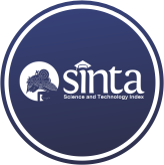Klasterisasi Sebaran Kasus Covid-19 Di Kota Denpasar Menggunakan Algoritme K-Means
(1) STMIK STIKOM Indonesia
(2) STMIK STIKOM Indonesia
(3) STMIK STIKOM Indonesia
(*) Corresponding Author
Abstract
Full Text:
PDFReferences
R. A. Indraputra and R. Fitriana, “K-Means Clustering Data COVID-19,” vol. 10, no. 3, pp. 275–282, 2020.
P. L. O. Permadhi and I. M. Sudirga, “Problematika Penerapan
Pembatasan Kegiatan Masyarakat (Pkm) Kota Denpasar Berbasis Adat Dalam Upaya Penanganan Covid-19,” Pros. Webinar Nas. …, 2020, [Online]. Available: http://e-journal.unmas.ac.id/index.php/webinaradat/article/view/1169.
T. Khotimah et al., “Clustering The Development Of The Covid-19 Case In Indonesia,” vol. 1, no. 1, pp. 23–26, 2020.
S. Sindi, W. R. O. Ningse, I. A. Sihombing, F. Ilmi R.H.Zer, and D. Hartama, “Analisis Algoritma K-Medoids Clustering Dalam Pengelompokan Penyebaran Covid-19 Di Indonesia,” Jti (Jurnal Teknol. Informasi), vol. 4, no. 1, pp. 166–173, 2020.
N. Dwitri, J. A. Tampubolon, S. Prayoga, F. Ilmi Zer, and D. Hartama, “Penerapan Algoritma K-Means Dalam Menentukan Tingkat Kepuasan Pembelajaran Online Pada Masa Pandemi Covid-19 di Indonesia,” Jti (Jurnal Teknol. Informasi), vol. 4, no. 1, pp. 101–105, 2020.
W. Yustanti, N. Rahmawati, and Y. Yamasari, “Klastering Wilayah Kota/Kabupaten Berdasarkan Data Persebaran Covid-19 di Propinsi Jawa Timur dengan Metode K-Means,” Journal Information Engineering and Educational Technology, vol. 04, no. 01. pp. 1–9, 2020.
A. Solichin and K. Khairunnisa, “Klasterisasi Persebaran Virus Corona (Covid-19) Di DKI Jakarta Menggunakan Metode K-Means,” Fountain Informatics J., vol. 5, no. 2, p. 52, 2020, doi: 10.21111/fij.v5i2.4905.
I. B. G. Sarasvananda, R. Wardoyo, and A. K. Sari, “The K-Means Clustering Algorithm With Semantic Similarity To Estimate The Cost of Hospitalization,” IJCCS (Indonesian J. Comput. Cybern. Syst., vol. 13, no. 4, p. 313, 2019, doi: 10.22146/ijccs.45093.
J. Hutagalung, N. L. W. S. R. Ginantra, G. W. Bhawika, W. G. S. Parwita, A. Wanto, and P. D. Panjaitan, “COVID-19 Cases and Deaths in Southeast Asia Clustering using K-Means Algorithm,” J. Phys. Conf. Ser., vol. 1783, no. 1, p. 012027, 2021, doi: 10.1088/1742-6596/1783/1/012027.
A. F. Khairati, A. A. Adlina, G. F. Hertono, and B. D. Handari, “Kajian Indeks Validitas pada Algoritma K-Means Enhanced dan K-Means MMCA,” Pros. Semin. Nas. Mat., vol. 2, pp. 161–170, 2019.
DOI: http://dx.doi.org/10.30645/j-sakti.v5i2.357
Refbacks
- There are currently no refbacks.
J-SAKTI (Jurnal Sains Komputer & Informatika)
Published Papers Indexed/Abstracted By:
Jumlah Kunjungan :











